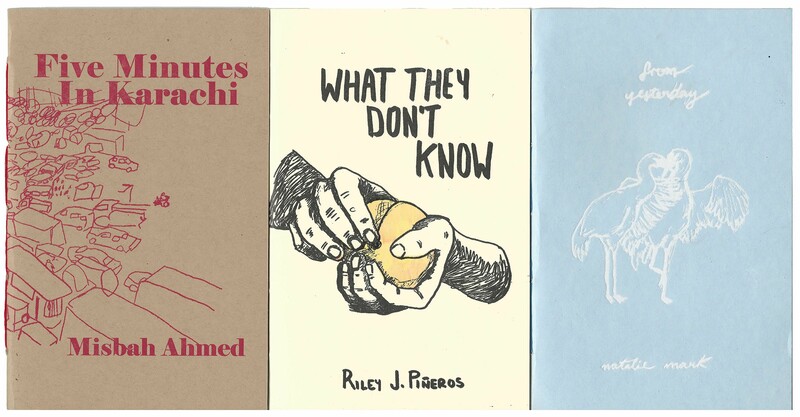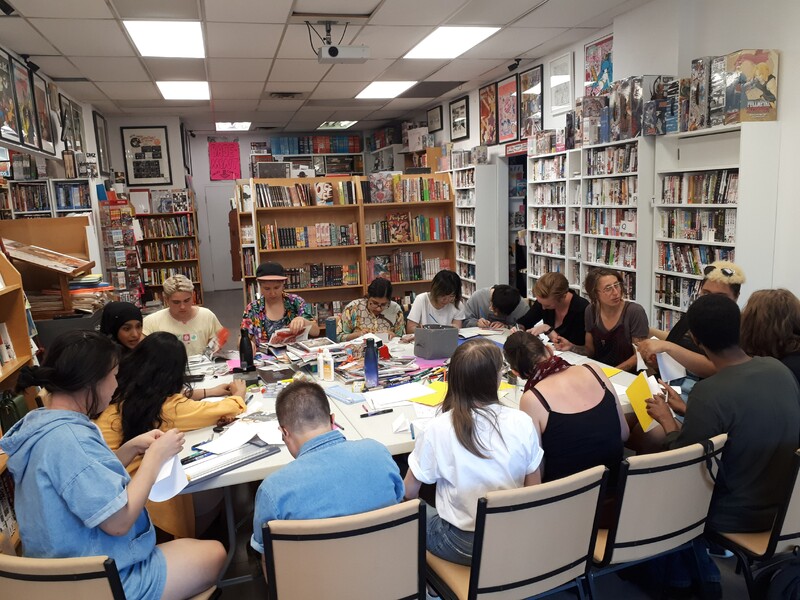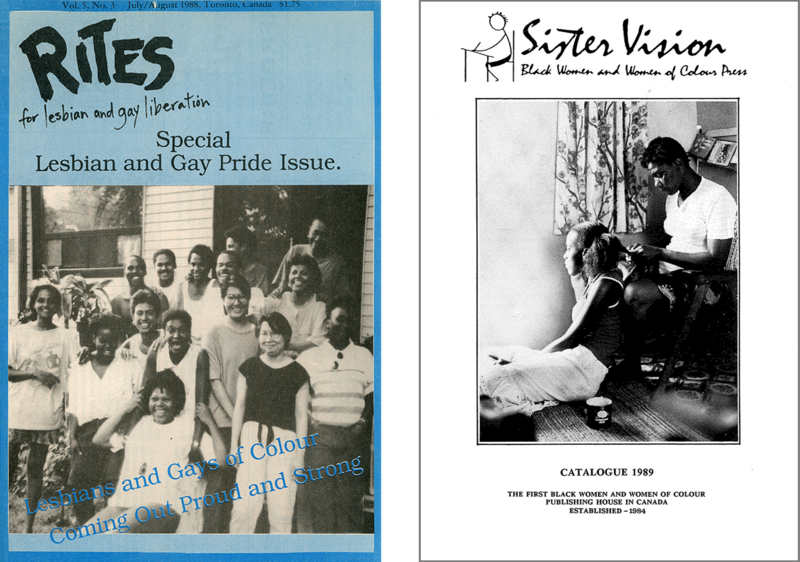- 11.0Cover
- 11.1How to Read this Broadsheet
- 11.2Power of PeopleAyodamola Tanimowo Okunseinde
- 11.3Walking through Mishibizhiw: Challenging the Measured Pace of ColonizationTasha Beeds
- 11.4Permanent PrecarityMostafa Henaway
- 11.5Soundpace // Eavesdropping on the Process of Dilettante ComposerOana Avasilichioaei
- 11.6Bringing the Decolonial into Kinesiology, Health, and Sport EthicsJanelle Joseph, Debra Kriger
- 11.7The Territory Between UsLee Su-Feh, Bracken Hanuse Corlett
- 11.8"Ensuring I Can Let People Know They Exist": Continuities of Black Feminist Publishing in TorontoAdwoa Afful, Cleopatria Peterson, Corinn Gerber
- 11.9Wayside SangCecily Nicholson
- 11.10Full StopMaandeeq Mohamed
- 11.11In Spite of DefeatismJacob Wren
- 11.12Glossary
"Ensuring I Can Let People Know They Exist": Continuities of Black Feminist Publishing in Toronto
- Adwoa Afful
- Cleopatria Peterson
- Corinn Gerber
A conversation between Cleopatria Peterson and Adwoa Afful, as listened to by Corinn Gerber
How is storytelling related to publishing? The participants of the following conversation—Cleopatria Peterson, co-founder of Old Growth Press, and Adwoa Afful, founder and project manager of Mapping Black Futures—each establish this relationship in a different way. While the authors of Old Growth Press tell stories using words and images, Mapping Black Futures is an interactive online resource. The conversation interweaves these two contemporary approaches with that of Sister Vision Press, founded in 1984 to publish the work of Black women, women of colour, and Indigenous women living in Canada. One of Sister Vision’s initial priorities was the publication of oral histories. Co-founder Makeda Silvera contributed to the run-up to this conversation but ultimately was unable to attend. In this intergenerational exchange, Black feminist publishing’s ongoing inventions of the relation between storytelling and publishing emerge as a powerful force shaping the Greater Toronto Area—a force that continues to make meaning despite the ongoing attempts at epistemological erasure performed by dominant narratives of the city.
Cleopatria Peterson: I think [the relation between storytelling and publishing] comes down to representation, which has been politicized, capitalized, to a degree where it means nothing anymore. Being able to tell your own stories and see yourself in that, and encouraging people to tell their own stories so they can see themselves in the world, is something that’s very important to my practice—and something that I experience a lot of fulfillment from when telling stories. So, [it’s important to me to use] whatever knowledge base or skills I have to assist others in doing that, even outside of Old Growth Press. I’m always teaching zine-making workshops to encourage and teach skills, so people know how to self-publish their own work in a cheap, affordable way.
The more we can disseminate our own personal stories and work, the more we can see ourselves in spaces, and the less we can feel alone. Then more people may be able to treat us as human beings as opposed to a diversity win, which is what we are seen as in a larger landscape, which is really disappointing. I am especially seeing that as a bookseller. It’s really frustrating to see twenty books by white authors, and then one or two books by Black authors, or one transgender novel. If you’re not the majority, which is cisgender and white, then you are only allowed one book, one each year, to be the only person with that identity. That’s not true to how the world works. This speaks a lot to how there are people creating the work you want to see, but they’re not creating it at the level that is Penguin Random House, for example. Not everyone knows how to have access to that, or where to find it. And it is a bit harder to find. So, the more you create work—where you tell stories and where it’s disseminated—the easier people can find it, and the more I empower them.

Adwoa Afful: I should say that I’m speaking mostly for myself, and am not speaking for the other people who participate in Black Futures Now. Throughout my career, I have worked for nonprofits and in the public sector, so storytelling takes on a very specific connotation for me. Storytelling is often the way in which these organizations try to gain entry into various communities, specifically communities of colour. Often, the narratives around those communities is what organizations try to engage with first. This helps them determine their plans and policy-making processes around engaging those communities. So, for me, storytelling comes very much from a civic place: What are the stories we tell ourselves or that have been told to us about where we live? [About] the city, how it functions, what our role is in it, and who occupies which spaces? And who belongs in which spaces? One of the reasons why Black Futures Now started was because, while myself and my partner were in school, we kept learning or hearing about what were essentially stories about the city that didn’t include any perspectives or any stories or experiences of Black women. Later, we expanded Black Futures Now to include people who are outside of gender binaries or norms. We asked ourselves: What does not being included in those stories do to the communities that are still experiencing the impact of whatever decision is coming as a result of that?
Our goal was initially to expand those stories. Over time, that goal has evolved to not so much expand, but forefront, the stories that were already existent in the communities that we belong to, or among people we interacted with, but we didn’t see them being documented to the same extent or given the amount of attention they deserved. Because one of the ongoing issues in Toronto, Ontario, or Canada more broadly is that—when you look at not even just histories, but anything around policies—traditionally it has been to actively erase those stories or ignore them. We wanted to counteract that erasure through our own work, but then also provide a space online that was accessible for people who were looking for these stories and wanted a spot where they could be active participants in the creation of them. People who specifically identify as Black, as nonbinary, as women, and as trans. Because even within the communities that we belong to, we also found that still, there’s layers, right? There’s always hierarchies. We found that the stories that did end up making it to the forefront did still privilege a very cis, het, middle-class, older, mostly male perspective, even if we’re talking among people of colour. So that’s what we wanted to focus on.

Corinn Gerber: Maybe here is a good point to weave in Sister Vision Press. Because you were talking about stories that disappear again, right? You were talking about erasure even. What does the story of Sister Vision mean to you? Do you know about Dewson House? Do you know those stories?
AA: I know about Dewson House through one of the youths who worked on our project. They did research and then brought that up to us. So, they’re actually featured on our website.
CP: I’ve heard of Sister Vision Press. It’s something I’ve been interested to delve into. But it would be something I have to teach myself, as opposed to having that information accessible to me. Which is weird, having gone [through] a publications program. You would think that maybe it would get touched on a bit, but it has not. So, I would love to hear from you.
CG: I can’t speak for Makeda, but there is publicly accessible information, for instance, Makeda Silvera just shared her memories of Dewson House. There are Sister Vision’s own publications, some of which you can still get. The movie Our Dance of Revolution (2019) about Toronto’s Black queer histories opens with Makeda talking about Dewson House. A lot of the organizations that later came to make spaces for LGBTQ2S+ Black, Indigenous, and people of colour in Toronto came out of that house. For instance, Zami, Lesbians of Colour, and Sister Vision Press, which was Makeda’s press together with her then life partner, Stephanie Martin. They started in the basement of Dewson House. Later, Sister Vision shared an office with Fireweed magazine, on whose board Makeda also sat. That office was on Baldwin Street, neighbouring Women’s Press, who then began to distribute Sister Vision’s books. So the stories are very much tied to places in the city, as in the map of Mapping Black Futures. Where are you printing your publications, Cleo?
CP: We definitely switch. We do the interior somewhere else. We used eco-printed paper for our first run with books that had embossed and screenprinted covers. When I was at OCAD [Ontario College of Art & Design, Toronto], I got to use their letterpress, so I really miss having access to a print studio for free. I was doing the labour of printing covers. And for our second run, we got our covers Risograph printed, and we used Vide Press. So, West End, centrally. We actually found a really great Black-owned print shop to do the interior printing for our second run: Omazzii, and they’re located centrally, [in the] Bay-Yonge area. They were amazing to work with, [and] had the best prices. It was really great. We definitely recommend them for printing projects.

CG: Maybe that leads to: What does Tkaronto/Toronto mean to you? And how is Toronto linked to places outside of it?
AA: Mapping Black Futures is very much a geographically specific collective. Geography means a lot in terms of how we organize ourselves, what informs our mission, and who we engage with. That said, this [question] came out a lot through the youth that we engage with in our Mapping Black Futures project. When we first started our project, we had to have a long discussion about what constitutes Toronto, what constitutes the GTA. Because as much as we like to think of Toronto itself as a diverse city, a lot of the diversity is concentrated on the peripheries of the city. So, we would have to extend to Brampton and other parts of the city that may not be considered in official city maps and guidelines as part of Toronto. I guess the point is that there are multiple Torontos. There’s the official Toronto that you’ll see in various city-planning guidelines, then there’s a Toronto that’s connected to culture. And then there are pockets of Toronto that primarily certain populations connect to, but that aren’t really considered when you think of what makes this city.
CP: I think we could run Old Growth Press anywhere. It’s not really tied geographically. So we are quite different in that way. We are all based in Toronto, but the work we’re doing is not specific to Toronto. For instance, Natalie Mark [one of our authors] is from Winnipeg and the prairies. So their work speaks to their experiences of the prairies. Misbah Ahmed’s work is about Karachi. So it’s more of an outward presentation of who exists in Toronto, through their work. And we welcome anyone from Canada to publish with us or submit. For me as an artist in Toronto, I find it hard to exist in these spaces. Because any space that represents any part of my identity disappears very quickly. There are no permanent spaces; they’re all very transient. The places that are permanent are so white, and then feeling like an outsider in those spaces . . . [It’s] a huge problem. But also, where else do you go? And also knowing that you are a settler on this land.
AA: That’s why we ended up moving online. Because it was, for better or worse, one of the very few spaces that actually was open. But it is telling that the few spaces that met all of our needs [are] virtual spaces. It’s not perfect. But it’s one of the more accessible ways to claim space in the city. Which is ironic, because it’s not actually claiming space in the city, literally.
CP: The only permanent space I can think of that is Black-run and for Black folks is Nia Centre for the Arts, which just opened. We have one out of how many others? And it makes me think of Glad Day Bookshop, how they had to move, and I’m sure there’s not anyone Black funding Glad Day. I’m not saying Glad Day doesn’t do important work and have space for Black people. But I remember going there for [a] publication class, and I don’t know who we were talking to, [but] we were trying to ask about PoC in the queer community in the past. I think it’s funny that you’re like: “Oh, Sister Vision was on Baldwin Street,” and during all this they were like, “Oh, Black people weren’t really around back then.”
AA: That’s the erasure we were talking about. One of the ongoing issues with being Black in Toronto is that people think you’re new all the time. There’s no sense that there have historically been communities here from the beginning. If you’re doing anything that’s Black-centred, queer-centred, you become an archivist, regardless of what your project is. No matter what you’re doing, there’s always a piece of education and research and historical work that you need to do, to underscore why you should be doing the work that you’re doing, or why you should exist as a project. That I’m often happy to do, but that maybe isn’t required of other groups to do. So we don’t have archives, we don’t have easily accessible histories.

CP: You really have to prostrate yourself as a diversity win in a way. Just existing in any space, really, it’s a bigger problem. It’s not just publishing. And then I think in publishing, as a creator who is Black, you should be writing Black stories, and what are Black stories? Anything I write is a Black story, because I’m Black and I’m writing it.
AA: It’s vital work; we get a lot of feedback. But if it’s vital work, then why aren’t we able to compensate [people for] it? I have a day job. I think you have a day job, too, Cleo. There is a cycle that’s perpetuated. I think it’s not as documented as well as it should be, because documentation, archiving, it takes extra work. And I think people expect it to happen, almost spontaneously, by the communities that are already disproportionately impacted by [the uneven distribution of labour]. So there needs to be a more intentional effort, and an effort that’s consistently funded in order to keep these things going.
CG: There’s an institution needed, actually—whatever form it takes—that takes on the labour of archiving those stories. [An institution] where you could go and you would find materials.
AA: There’s the queer archives in Toronto [the ArQuives: Canada's LGBTQ2+ Archives], which is important. They do have some old queer magazines, like Zami. But that’s still a largely—
CG: There’s lots of gaps in there.
AA: There’s a lot of gaps, right? And it’s not necessarily a Black-run or Black space.
CP: I’ve also had the archives tell me that they didn’t really have any stuff [about communities of colour]. So they’ve applied the same white queer perspective, where Black people or people of colour weren’t really a part of Toronto, which is not true. So much of that history is lost. How do you fill those gaps?
CG: Do you know Courtnay McFarlane? He curated a show in 2019 called See We Yah!, as the first show of the Legacies in Motion: Black Queer Archival Project [at BAND Gallery, Toronto]. He has this growing archive in his home, [which he] branched out into the community. So, the work is being done. But you’re right: it’s still being done by individual people. And Courtnay is doing much more than he ever gets paid for in the framework of one exhibition.
CP: I think that’s just how it’s built. That we don’t survive our work. I think it’s built like that on purpose. The lack of an archive of my identities is how I approach hoarding. There’s publications that I purchase, or make sure I have, because I want to leave that behind for people in some way. I love publishing books and I am trying to think critically about my love of publication and books in an environmental capacity, now with how we are with our climate, of course. But [I’m] just ensuring that I can let people know they exist in the things that I have collected throughout my years of living.
See Connections ⤴
Cleopatria Peterson is a multidisciplinary artist who writes, printmakes, illustrates, and loves self-publishing. They graduated from the Fashion Communication program at X University, Toronto, and won the medal for Cross-Disciplinary Arts: Publications at OCAD University, Toronto. Their work focuses on themes of nature, healing, and care. Peterson is a huge advocate for encouraging people from all backgrounds to make art and is the co-founder of Old Growth Press, a small press working to change the publishing landscape with work from POC and LGBTQ+ creators.
See Connections ⤴
Corinn Gerber is a PhD candidate at the University of Toronto. She is the co-founder of Passenger Books and has worked as a publisher and bookseller at various institutions in Toronto, Montreal, Berlin, Cologne, and Zurich. Her dissertation is dedicated to how Black and Afro-German feminist publishers make meaning in these places.
See Connections ⤴